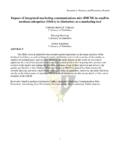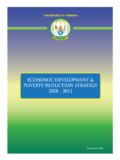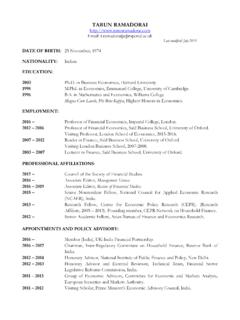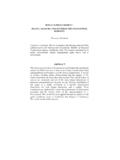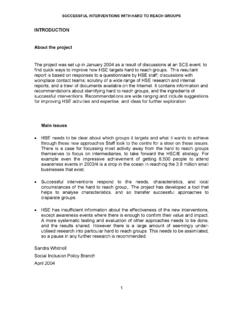Transcription of HEALTH CARE SYSTEMS: GETTING MORE VALUE …
1 Please cite this paper as: OECD 2010, HEALTH care systems: GETTING more VALUE for money , OECD Economics Department Policy Notes, No. 2. Economics Department Organisation for Economic Co-operation and Development ECONOMICS DEPARTMENT POLICY NOTE No. 2 HEALTH care SYSTEMS: GETTING more VALUE FOR MONEY 2 3 HEALTH care systems: GETTING more VALUE f or money The OECD has assembled new comparative data on HEALTH policies and HEALTH care system efficiency for its member countries. The aim is to better identify strengths and weaknesses of each country s HEALTH care system and assess whether there is scope for improving VALUE for money and the policy reforms that will boost efficiency. Key findings are as follows: There is room in all countries surveyed to improve the effectiveness of their HEALTH care spending.
2 On average across the OECD, life expectancy at birth could be raised by more than two years, while holding HEALTH care spending steady, if all countries were to become as efficient as the best performers. By way of comparison, assuming no reform, a 10% increase in HEALTH care spending would increase life expectancy by only three to four months. There is no HEALTH care system that performs systematically better in delivering cost-effective HEALTH care . It may thus be less the type of system that matters but rather how it is managed. Both market-based and more centralised command-and-control systems show strengths and weaknesses. HEALTH outcomes are highly disparate across individuals and such inequalities can be reduced without sacrificing efficiency. Inequalities tend to be relatively low in countries with a well-regulated private insurance-based system .
3 Centrally-managed systems can also deliver good equity outcomes at the same time as keeping spending low. There is no one-size-fits-all approach to reforming HEALTH care systems. Policymakers should aim for coherence in policy settings by adopting best practices from the many different HEALTH care systems that exist in the OECD and tailor them to suit actual circumstances. By improving the efficiency of the HEALTH care system , public spending savings would be large, approaching 2% of GDP on average in the OECD. There is a clear need to contain public spending on HEALTH care 1. Achieving VALUE for money in the HEALTH care sector is an important objective in all OECD countries. HEALTH care spending per capita has risen by over 70% in real terms since the early 1990s.
4 This is reflected in a significantly healthier population as shown by increased life expectancy and lower mortality for diseases such as cancer. Indeed, life expectancy has increased, on average, by about 1 year every 4 years since the early 1990s. But, as a result of the run-up in outlays, total spending on HEALTH care now absorbs on average over 9% of GDP in the OECD, though with a wide cross-country variation. And the countries that spend the most are not necessarily the ones that fare best in terms of HEALTH outcomes (Figure 1), suggesting that there is scope to improve the cost-effectiveness of spending. 2. HEALTH care spending indeed needs to become more effective. Otherwise, HEALTH care demand will undermine public finances. The recent crisis and its impact on public budgets have heightened pressures for reform and made it more urgent.
5 Public spending on HEALTH care is one of the largest government spending items on average it absorbed 15% of general government spending in 2007 ( more than 6% of GDP), up from 12% in 1995. Furthermore, population ageing, rapidly rising HEALTH care prices and costly developments in medical technology are putting upward pressures on HEALTH care budgets. The OECD projects that public HEALTH care spending could increase by to 6 percentage points of GDP by 2050 across the OECD countries. 4 Figure 1. There are large differences in life expectancy and HEALTH care spending across OECD countries 20081 1. Or latest year available. Source: OECD HEALTH Data 2010. The efficiency of HEALTH care systems could be increased significantly, helping fiscal consolidation 3. Governments care both about the HEALTH status of populations and budget sustainability.
6 There is no doubt that healthier populations are important for thriving economies, but could better HEALTH outcomes be achieved while reining in spending pressures? New research suggests that all OECD countries could get better VALUE for money from their HEALTH care spending. One way of gauging the efficiency of HEALTH care spending treats life expectancy as the outcome of HEALTH spending. True, it is only a partial indicator since it does not reflect the prevalence of disease, disability or quality of life and data constraints are significant. Nevertheless, as research by Joumard et al. (2008) shows, life expectancy is highly correlated with other indicators of HEALTH status, including infant and premature mortality and better quality of life due to improved medical treatment.
7 Life expectancy reflects not just HEALTH spending but also choices of lifestyle, such as tobacco and alcohol consumption and education levels. These factors have been taken into account when assessing the efficiency of HEALTH care spending. Various methods and assumptions about the effect of HEALTH care spending on life expectancy have been tested and the results are robust. Overall, they suggest that: On average across the OECD, life expectancy at birth could be raised by more than two years holding HEALTH care spending steady if all countries were to become as efficient as the best performers. By way of comparison, a 10% increase in HEALTH care spending would increase life expectancy by only three to four months. The potential for efficiency gains varies widely across countries, from less than one extra year of life expectancy in Australia to over 4 years in Hungary (Figure 2, Panel A).
8 Australia, Iceland, Japan, Korea and Switzerland perform best in transforming spending into HEALTH outcomes. 5 In more than one third of OECD countries, exploiting efficiency gains in the HEALTH care sector would allow improving HEALTH outcomes as much as over the previous decade while keeping spending constant (Figure 2, Panel B). Germany, the United Kingdom and the United States fall into this group. In a majority of OECD countries, however, continuing to improve HEALTH outcomes would require increasing HEALTH care spending, though by a smaller amount than over the previous decade. By improving the efficiency of the HEALTH system , public spending savings would be large as compared to a no-policy-change scenario, amounting to almost 2% of 2017 GDP on average in the OECD.
9 It would be over 3% for Greece, Ireland and the United Kingdom (Figure 2, Panel C). There is no trade-off between achieving more equal HEALTH outcomes within countries and raising the average HEALTH status of the population. Indeed, the countries with the lowest HEALTH inequalities also tend to enjoy high HEALTH status Iceland, Italy, and Sweden are good examples. 6 Figure 2. Achieving efficiency gains would help contain spending over time 1. Potential gains are derived from an output-oriented data envelopment analysis (DEA) performed with one output (life expectancy at birth) and two inputs ( HEALTH care spending and a composite indicator of the socio-economic environment and lifestyle factors). They are measured by the number of years of life that could be saved if efficiency in country i were to be raised to the level implied by the estimated efficiency frontier while holding inputs constant and under the assumption of non-increasing returns to scale.
10 2. For the period 2007-17: assuming that countries exploit estimated potential efficiency gains, life expectancy over the period 2007-17 could increase at the same pace as over the previous ten year period but at a much lower cost in many countries. 3. Potential savings represent the difference between a no-reform scenario and a scenario where countries would become as efficient as the best performing countries. Source: OECD HEALTH Data, 2009; OECD calculations. 7 Policies and institutions to steer the demand and supply of HEALTH care services differ 4. The new dataset on HEALTH policies and institutions reveals that: The basic insurance coverage measured by population covered, services included and the degree of cost-sharing is fairly similar across countries.











